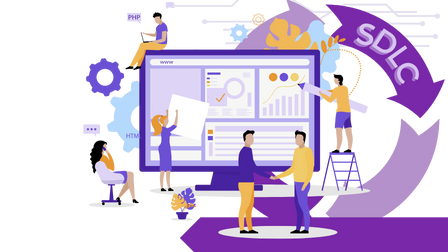Enrolment options

This course provides an overview of the practices and methodologies involved in systems development. Learners will be introduced to fundamental concepts, models, and techniques used in each phase of the Systems Development Life Cycle (SDLC).
The course objective is to empower learners to understand and effectively apply SDLC principles in software development projects in Health Information systems
Who is this course for?
This course is designed to build or enhance
abilities to contribute to software development projects. While much of
the material applies across domains, the course will highlight specific health
information systems (HIS) considerations. It is helpful for both those
who are new to systems development projects as well as an opportunity to
refresh or mature skills or project processes for HIS roles such as:
- Health system leaders
- Project manager
- Business analyst
- Programmer/developer
- Quality Assurance (QA) tester
- UI/UX designer
- Systems Users
- Implementers
What will you learn?
By the end of this course, participants will
be able to:
- Articulate the purpose of the Systems Development Lifecycle
- List techniques for gathering, documenting, and analyzing user requirements effectively
- Understand the importance of stakeholder collaboration and communication in requirements elicitation
- List key design principles
- Describe practices for writing clean, modular, and maintainable code
- have an awareness of the different testing methodologies and techniques to ensure software quality: Testing, User acceptance testing, production environment, and feedback process
- Identify deployment strategies and techniques for releasing software systems into production environments
- Identify the importance of ongoing maintenance, updates, and support for software systems post-deployment
- Understand change management principles and practices, with a focus on the Systems Development LifeCycle (SDLC) context.
How much time do you need to invest? Completing the course should take 3 hours
Topics overview:
- Introduction to SDLC
- Techniques for Gathering and Analyzing User Requirements
- Systems Design methodologies
- Writing Clean, Modular, and Maintainable Code
- Testing
Methodologies and Techniques
- Deployment
Strategies and Techniques
- Importance
of ongoing maintenance, updates, and support
- Change management
Recommended browser: Chrome or Edge
Contributors: Jembi Mozambique, Regenstrief Institute Inc., German Cooperation Deutsche Zusammenarbeit, GiZ, & DIPC. Thank you to the GIZ DIPC project for supporting the creation of this course. Special thanks to the Jembi Mozambique team and all of those in the DIPC project and in the global health community who contributed to the materials. Additionally, thank you to the Luddy School of Informatics students for their collaboration and dedication in this effort.
Certificate: A PDF Certificate will be generated upon
successful completion of the course.
Course Provider: GIZ, Regenstrief Institute
Course Developers: Jembi and Regenstrief Institute
Course Contact: Cindi Hart
In case of technical troubleshooting or questions, don't hesitate to get in touch with the atingi team via the atingi help desk.
License: CC BY NC SA
Publication Date: 08.10.2024